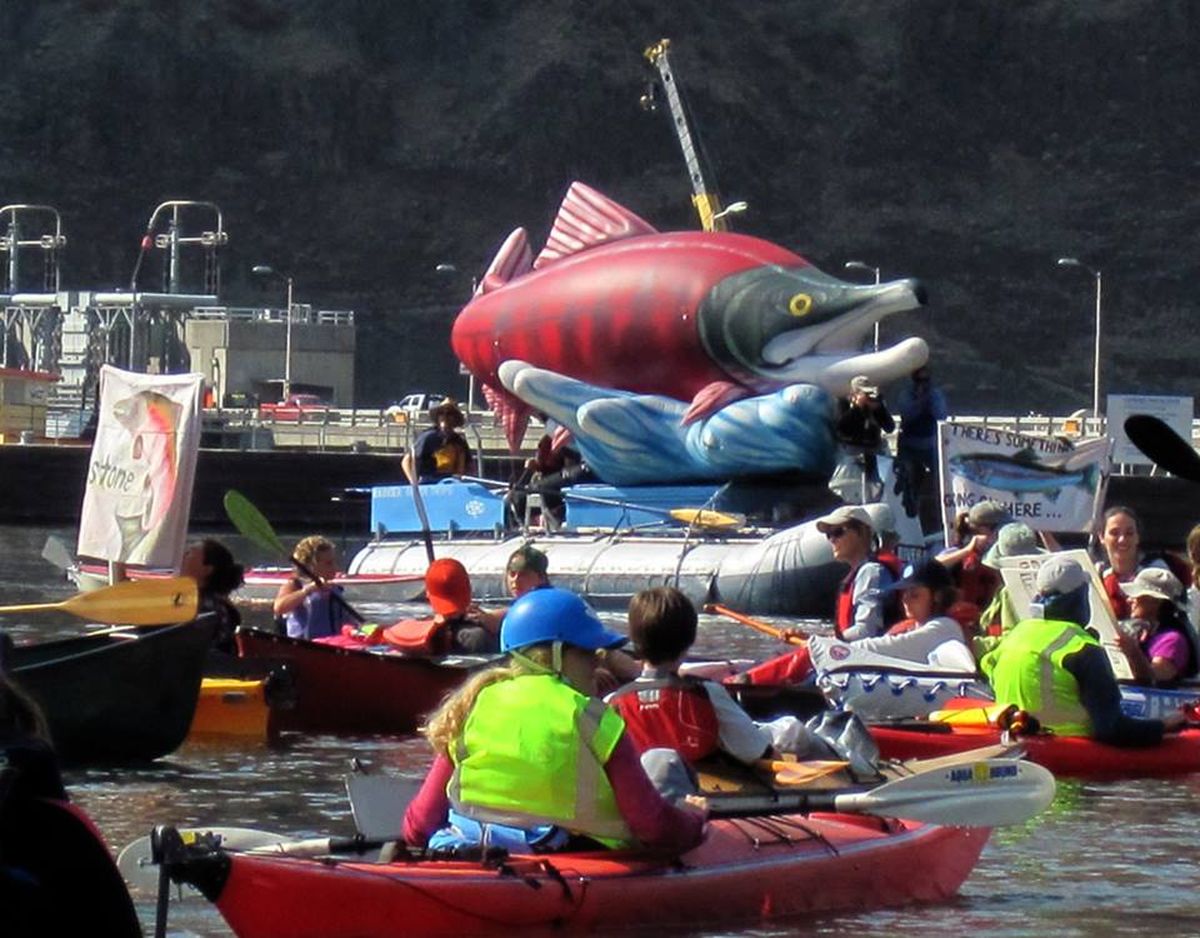Free the Snake event lures flotilla to protest dams
About 150 boats participated in the Free the Snake protest at Lower Granite Dam on Oct. 3, 2015. (Ben Moon)
Updated with fix to quote attribution
RIVERS -- Up to 300 paddlers advocated removal of the lower four dams on the Snake River on Saturday with a peaceful Free the Snake protest that staged near Lower Granite Dam.
The conservationists converged on the lower Snake to protest what they call four "do-nothing dams that consume taxpayer dollars while inflicting an extreme toll on Idaho’s endangered salmon," according to Idaho Rivers United, one of the groups involved.
The U.S. Army Corps of Engineers has a different view point, which is posted below.
The Free the Snake Flotilla protesters contend the dams cause costly harm to Snake River salmon and steelhead. They say the relatively little power generated by the dams doesn't cover the losses to fisheries and the outfitting that could be done on the river if it were returned to free-flowing condition.
The barging industry is heavily subsidized and could be replaced by rail, they say, adding that the energy produced by the dams could be made up by green alternatives.
Save Our wild Salmon, another group involved in the protest, says it is committed to working with farmers and others to further support the shift to rail and other transportation that is already occurring.
"We look forward to working with other stakeholders to bring back the tremendous fish and wildlife habitat, recreational opportunities, orchards, free-flowing waterfront (instead of the Lewiston levies) and other values now lost under stagnant reservoirs," said Sam Mace, SOS spokeswoman in Spokane.
Participants in the flotilla gathered at Wawawai Landing on the north bank of Lower Granite Lake, the farthest upstream of the four lower Snake River reservoirs and 3 miles from Lower Granite Dam. The flotilla headed toward Lower Granite Dam where the main rally in support of a free-flowing lower Snake River was held before paddling back.
Meanwhile, here's a statement from Lt. Col. Tim Vail, Commander of the U.S. Army Corps of Engineers, Walla Walla District, who contends that Snake River dams provide outstanding value.
We've heard a lot of discussion about the Corps' four dams on the lower Snake River. I'd like to take a few minutes and tell you why they provide outstanding value to the Nation.
The four lower Snake River dams provide a great return on investment. These dams cost $62 million per year to operate, an investment that generates more than $200 million per year of clean, renewable electricity, enough to power 675,000 residences. This investment also provides a marine transportation corridor that helps move 3.5 million tons of cargo, worth $1.5 billion a year, to regional markets, which improves the region's economic competitiveness. And this investment provides recreation facilities that host 2.8 million visitors per year. These four dams also benefit the environment by allowing us to avoid the 7,300 kilotons of carbon dioxide pollution that a coal-fired power plant would emit to generate the same amount of electrical power.
Snake River dams also are able to meet peak power loads using turbines that can be adjusted in seconds. The flexibility of hydropower dams makes it possible to integrate highly-variable wind energy into the power grid. When the wind speed changes, some power source has to be immediately ready to add or reduce power to keep the grid stable; hydropower provides that capability. Coal and nuclear power plants require hours for their power output to be adjusted.As for our fish recovery efforts, the lower Snake River dams are equipped with the most advanced fish passage systems in the world and our fish program is one of the largest fish conservation efforts in the Nation. Fish passage systems like spillway weirs are in place on all our Snake River dams. Survival rates for juvenile fish through spillway weirs range from 95-100%. The investments in fish recovery are paying dividends. Last year brought some of the highest Fall Chinook, Coho and Sockeye salmon returns to the Lower Snake River since Snake River dam construction began in 1962. Corps scientists and engineers team with our many partners to prove dams and fish can co-exist.
This year hot weather and drought conditions presented challenges to fish passage and survival. However, working with numerous regional partners to maximize fish survival we still observed the 3rd highest fall Chinook salmon returns over Lower Granite Dam and the 10th highest Snake River Sockeye salmon return since the dam was constructed. Conditions were unfavorable throughout the Pacific Northwest, but in the Lower Snake River fish managers were able to improve conditions by modifying spill patterns and by releasing cool water from Dworshak Reservoir to moderate temperatures affecting fish in the lower Snake River.
As we face future challenges with optimizing fish recovery, ensuring the efficient flow of goods through the Snake River navigation channel and providing low cost energy, I am confident that, with the support of the American people, we will continue to ensure the Snake River dams provide outstanding value to the Nation.


